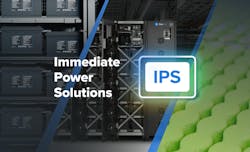The Emergence of Immediate Power Solutions (IPS) for Data Centers
When assessing energy storage solutions, a key consideration is the type of battery chemistry utilized to achieve the desired results. Different batteries offer varying strengths and weaknesses, where some offer greater power for shorter durations of time, while others can provide energy for extended periods at a lower discharge rate. They can also vary in their safety, reliability, and sustainability. As the role of energy storage grows in a 21st century economy, it’s essential to choose the best battery for each application, instead of taking a one-size-fits-all approach.
Long duration energy storage applications have traditionally been labeled Energy Storage Systems (ESS) and are exemplified by the powering of electric vehicles and consumer electronics. Alternatively, short duration applications that emphasize power over duration can be categorized as Immediate Power Solutions (IPS). A requirement of IPS applications is the availability of instantaneous, high-rate power for a range of minutes to microseconds. Applications for this type of short duration power delivery exist across multiple verticals including industrial and manufacturing, electric vehicle charging infrastructure and even support of long duration energy storage and generation products as they ramp up to peak power.
One of the most notable, fitting applications for IPS is in powering uninterruptible power supply (UPS) systems in data centers.
With the rise in consumer electronics, IoT, and AI, our dependence on digital infrastructure has never been greater, making data center uptime essential. Part of meeting these growing demands is that data center operators must address workplace safety, escalating property costs, and heightened sustainability concerns from regulators, investors and clients. These factors drive a shift towards backup power solutions that offer enhanced reliability, space efficiency, and environmental responsibility.
The increasing demand on data centers has created an environment where attempting to meet them without IPS yields sub-optimal results. Many current UPS systems are powered by ESS due to what was previously available and accepted as an industry standard. Legacy IPS solutions have been used in the past but typically sacrifice other benefits such as footprint or sustainability. However, more IPS battery offerings have emerged that are better suited for the purposes of powering a UPS system, as they can deliver immediate, high-rate power crucial for critical operations managing the transition between an outage and a backup generator, in a footprint that improves on both legacy IPS solutions and the ESS solutions being used today.
Lead-acid batteries, one of the oldest IPS battery technologies, are often perceived as a familiar and safe choice for UPS in data centers. However, they display shortcomings when it comes to their size, sustainability and power, and their suitability for UPS is eclipsed by more advanced technologies. The reality is that most data centers simply used lead-acid due to it being one of the only affordable and widely available options at the time. Luckily for data center operators, alternatives have emerged.
Lithium-ion batteries are an alternative that data center operators oftentimes consider for UPS systems, and are gaining in popularity due to their weight and size advantages compared to lead-acid. The amount of space a UPS system takes is of increasing importance, as data centers are facing the challenge of increasing real estate costs and are looking to maximize available space for profit-driving servers. However, due to their limited discharge rate to curb safety concerns, lithium-ion batteries are still considered ESS batteries and do not fully align with the needs of a UPS system.
Nickel-zinc batteries, on the other hand, are an IPS battery that offers superior power density compared to lead-acid and lithium-ion batteries. They can deliver immediate power to an entire data center while occupying less than half the space of lead-acid systems, freeing up room for additional servers, which impacts revenue. Nickel-zinc batteries also provide better reliability and avoid the thermal runaway issues of lithium batteries. Additionally, their lifecycle emissions are much lower than those of lithium and lead-acid batteries, with reduced water usage and energy demands.
Transitioning to advanced battery technologies once faced challenges like compatibility and high retrofitting costs, often due to the specialized safety equipment required for lithium-ion batteries. However, UPS cabinets have emerged that are designed for easy integration into existing systems, allowing straightforward replacement of ESS with IPS. This compatibility means key factors like efficiency, safety, and sustainability can be integrated into data center infrastructure without requiring major system overhauls.
As data centers continue to play a significant role in powering the global economy, reliable UPS systems are crucial. The need to eliminate the risk of an outage efficiently and effectively has created an environment where ESS is no longer an adequate answer to powering UPS. With previous gaps in available technology and difficulty of upgrading addressed, data centers are primed to maximize their reliability, safety and efficiency by embracing IPS for their UPS systems.
About the Author

Tod Higinbotham
Tod Higinbotham is CEO of ZincFive, a manufacturer of nickel-zinc batteries and power solutions. He has a strong track record of successfully growing advanced materials companies in the energy storage, semiconductor, and solar markets. He served as Executive VP/GM for ATMI and led the rapid growth of the company, which was sold for more than $1 billion. Tod was an executive member of the leadership team at Advanced Silicon Materials, a world leader in high-purity silicon materials, the business that was sold to REC to form their solar materials business. He was formerly the CEO of PowerGenix, the company that pioneered the novel nickel-zinc battery technology that has become the core of ZincFive’s solution portfolio.



